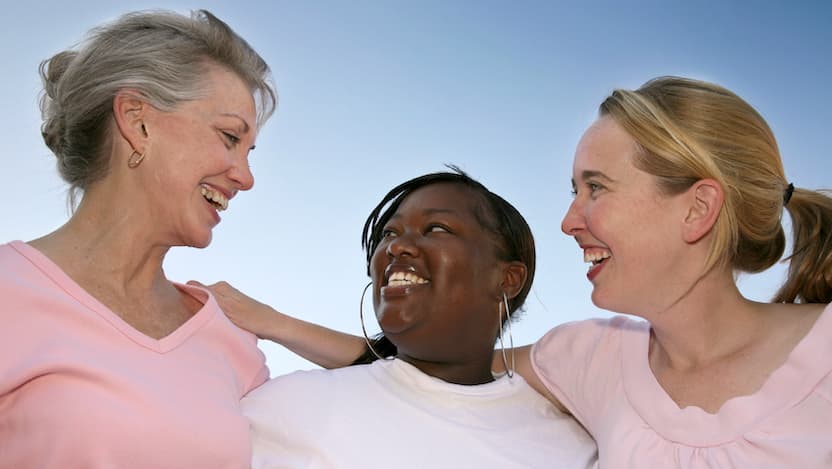Comparing African and European populations leads to breast cancer risk discovery

By comparing genetic data from European and African population groups, scientists at UChicago Medicine Comprehensive Cancer Center have identified seven new regions of the human genome that are associated with increased breast cancer risk.
In addition to laying a foundation for better risk modeling and more accurate genetic screening for cancer, the study highlights the importance of studying diverse patient populations, researchers said. The findings would not have been possible without incorporating data from African-American, Afro-Carribean and African women, said Dezheng Huo, PhD, Professor of Public Health Sciences and Medicine at UChicago Medicine.
“Previous studies mainly looked at European populations, and they missed this,” said Huo. “We just added a relatively small sample size of African-ancestry populations, and we found the locations.”
Although including women of African ancestry led to the discovery, the findings apply to women of both backgrounds, he noted.
The findings were published in July 2021 in Nature Communications.
For the new study, researchers analyzed genome-wide association studies (GWAS) of both European-ancestry and African-ancestry women. Each study compared genome scans of women with breast cancer and women who were healthy, with a goal of identifying genetic variants or mutations that may play a role in cancer.
The European study was large, with genetic data from more than 220,000 women. However, it was not until researchers compared it with a smaller data set of around 19,000 women of African ancestry that they identified seven regions on the genome that had previously been overlooked for cancer risk.
Previous studies missed the variants because they have weaker effects in women of European ancestry, Huo said.
Once the variants were identified in the African-ancestry population, researchers were also able to find them in the European-ancestry group and show that they were associated with breast cancer risk in that population as well.
“There are some variants that you can easily pick up in one population and not in other populations where the signal is weaker,” Huo said. “But once you pick it up, you find it doesn’t just apply to that group.”
Previous studies have identified genes associated with increased breast cancer risk, including BRCA1 and BRCA2. However, these two genes only account for a small proportion of cancers, and research is ongoing to identify more genetic risk factors. Most cancers, including breast cancer, are complex diseases driven by a combination of many gene mutations.
The seven regions identified by the study give scientists a “map” to narrow down the search for more genes that are part of the puzzle, Huo said.
As a next step, Huo and his team are working to use the newly discovered genetic markers to develop polygenic risk score models, research that could help make cancer risk assessments more accurate.
They also want to work with colleagues conducting laboratory studies to look closer at the genetic regions they found and try to identify the specific genes or mutations associated with cancer risk, as well as to better understand how they contribute to the development of cancer.
In addition to potential clinical applications, the study also points to the importance of diversity in genetic research, Huo said. For better data, future cancer research should include a variety of racial groups, including people of African, Asian, Hispanic and Native American ancestry, he added.
People of European ancestry are over-represented in medical research, Huo noted. That’s partly because they make up a larger share of the United States population, and may also be related to lower levels of trust for the healthcare system among some groups, he said.
“Without their inclusion in studies, we cannot discover this new knowledge,” he said.
The study, “Cross-ancestry GWAS meta-analysis identifies six breast cancer loci in African and European ancestry women,” was published in Nature Communications. Additional study authors include Babatunde Adedokun, Guimin Gao, Peter N. Fiorica and Olufunmilayo Olopade of the University of Chicago; Zhaohui Du, Sue A. Ingles, David V. Conti, Michael F. Press and Christopher A. Haiman of the University of Southern California; Thomas U. Ahearn, Regina G. Ziegler, Stephen J. Chanock, Montserrat Garcia-Closas, Cari M. Kitahara and Stefan Ambs of the National Cancer Institute; Kathryn L. Lunetta, Gary Zirpoli and Julie R. Palmer of Boston University; Jonine Figueroa of the University of Edinburgh; Esther M. John of Stanford University; Leslie Bernstein of City of Hope Comprehensive Cancer Center; Wei Zheng, Sandra L. Deming-Halverson and William Blot of Vanderbilt-Ingram Cancer Center; Jennifer J. Hu of the University of Miami; Sarah Nyante, Melissa A. Troester, Jeannette T. Bensen and Andrew F. Olshan of the University of North Carolina; Elisa V. Bandera of Rutgers Cancer Institute of New Jersey; Jorge L. Rodriguez-Gil of the National Human Genome Research Institute; Song Yao and Christine B. Ambrosone of Roswell Park Comprehensive Cancer Center; Temidayo O. Ogundiran, Oladosu Ojengbede, Adeyinka G. Falusi and Chinedum Babalola of the University of Ibadan, Nigeria; Katherine L. Nathanson of the University of Pennsylvania; Anselm Hennis of the University of the West Indies, Bridgetown, Barbados; Barbara Nemesure of Stony Brook University; Lara E. Sucheston-Campbell of The Ohio State University; Lawrence H. Kushi of Kaiser Permanente Northern California; Gabriela Torres-Mejia of Instituto Nacional de Salud Publica, Cuernavaca, Mexico; Donglei Hu, Laura Fejerman and Elad Zivof the University of California San Francisco; Manjeet K. Bolla, Joe Dennis, Alison M. Dunning, Douglas F. Easton, Paul D. P. Pharoah and Qin Wang of the University of Cambridge; Kyriaki Michailidou of The Cyprus Institute of Neurology & Genetics; Dale P. Sandler, Jack A. Taylor and Katie M. O’Brien of the National Institute of Environmental Health Sciences; Joel Yarney of the Korle Bu Teaching Hospital, Accra, Ghana; Baffour Awuah of the Komfo Anokye Teaching Hospital, Kumasi, Ghana; and Beatrice Addai-Wiafe of the Peace and Love Hospital, Kumasi, Ghana.
